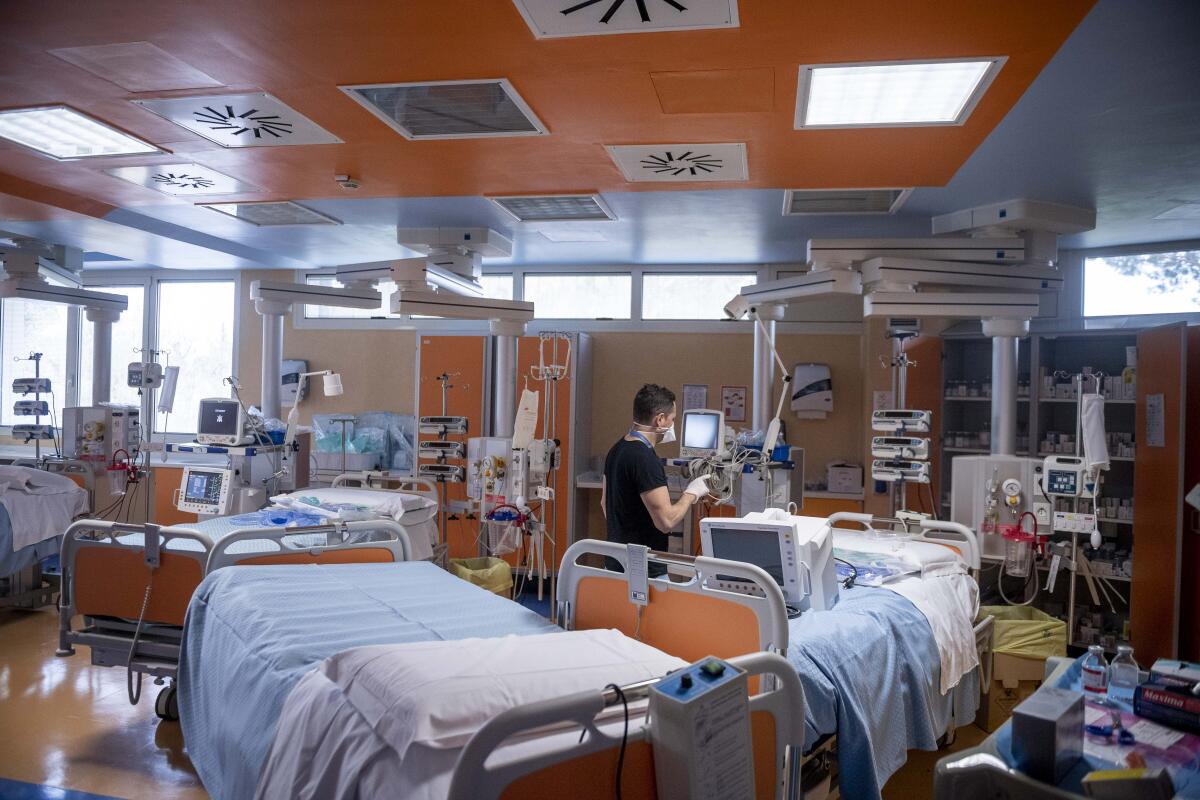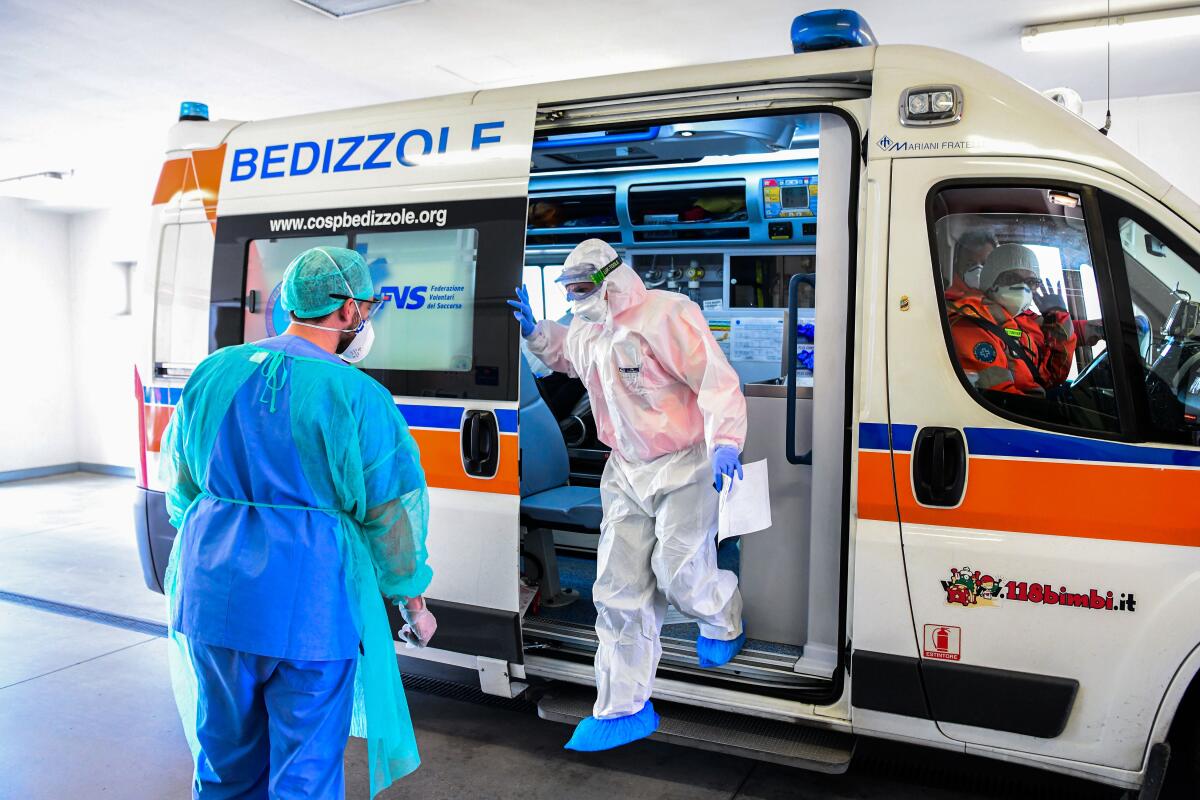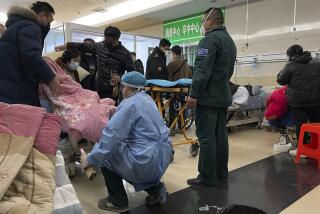Italy sees wartime-era stress at hospitals — and cemeteries

- Share via
ROME — In parts of Italy, the coronavirus means the local cemetery keeps its crematorium running 24 hours, the newspaper adds far more obituary space than normal and families yearn to touch loved ones in hospital isolation wards.
Hospital staffs often find themselves filling in where relatives and spiritual leaders cannot, even as they face their own risks of infection.
In some cases, doctors in overflowing hospitals are facing the toughest choice of their lives by determining which patient gets a lifesaving ventilator when there are not enough for everyone in need.
That is the kind of wartime decision-making that is now part of the shift at Bergamo’s Papa Giovanni XXIII hospital, where Dr. Fabiano di Marco has not had a day off since Feb. 21, the day the city realized the virus was in its midst.
“With so many locals getting sick we have faced an earthquake that would overwhelm the best hospital and which has made the last three weeks seem like years,” Di Marco, 46, the head of the hospital’s respiratory unit, said in a phone interview Monday night.

With a total of 3,993 cases reported Tuesday — a leap of 233 over the previous day — the province of Bergamo has had more infections than anywhere else in Italy, which in turn has seen a total of more than 31,500 cases and 2,500 deaths.
“This time last year we had four deaths a day here. Now you can quadruple that number,” Di Marco said.
To cope with the unexpected number of deaths, Bergamo’s cemetery has closed to members of the public wishing to visit a grave for the first time since World War II, turned its chapel into a morgue and is keeping the crematorium operating 24 hours.
Despite a growing number of cases in Bergamo, which is in the region of Lombardy, the town was not included on a list of 11 towns in Lombardy and the neighboring region of Veneto that were ringed with roadblocks and locked down last month when infections soared. Infections in and around Bergamo continued to rise, while the situation stabilized in the 11 towns.
On March 9, Italy’s government announced travel restrictions across the country and closed most shops, but that was too late for patients who had already died at the Bergamo hospital. The hospital has not released coronavirus-related death statistics.
This week, 78 coronavirus victims were using ventilators in the hospital’s intensive care wards, 12 were in semi-intensive care and more than 100 in wards without ventilators. Some patients were placed in beds in the emergency room because of space limitations.
The rush has forced doctors to make hard decisions. “Access to intensive care is always reserved for patients who can really benefit, but at a moment like this, with so many requests, the selection becomes crucial,” Di Marco said.
“Beds are not infinite and they are often given not to the most serious case, but to people with the best chance of survival. Lombardy has 1,100 intensive care beds and about 900 are now taken up by virus cases. We are facing very difficult choices,” he said.
“That alone creates stress for doctors, as does losing patients, who are often relatives or acquaintances of staff,” he said.
Dozens of staff members at the hospital have been infected despite wearing protective gear during long shifts, he said.
Dr. Stefano Fagiuoli, who manages the virus crisis unit at the hospital, said in a phone interview last week that he continued to work from home after becoming infected with the coronavirus until severe muscular pain in early March made it too painful for him to sit at his computer. He said he was recovering slowly in bed.
“Don’t underestimate this virus,” said Fagiuoli, who is 60 and lives in Bergamo. “There are clusters out there in Europe right now and it won’t be doctors and ventilators that stop it, it will be our ability to reduce contact.”
Di Marco has stayed free of infection. “You have to wear the masks tight to be effective, then you change them when you take them off, but since there is a shortage you have to keep them on for hours. That’s why we all have red marks on our face,” he said.
Meanwhile, local newspaper Eco di Bergamo has increased its pages devoted to obituary notices from about one to 10. Families who are unable to visit loved ones in isolation wards, or talk to them while they are hooked up to ventilators, are also denied seeing them when they are dead since family members must self-isolate.
Di Marco said he remains concerned that the worldwide response to the coronavirus has not been strong enough.
“To stop this thing there are no half measures,” Di Marco said. “You either do all or nothing. If you do nothing you will have hundreds and thousands of deaths. Or you try and slow it down by acting in a fast and radical way, like Italy is doing now. Unfortunately I can see the rest of the world still using half measures.”
Kington is a special correspondent.
More to Read
Sign up for Essential California
The most important California stories and recommendations in your inbox every morning.
You may occasionally receive promotional content from the Los Angeles Times.









